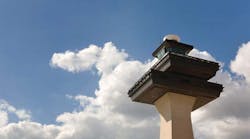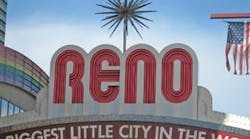March 19--Nevada airports are better economic drivers than those in nearly every other state in the country, a report prepared for Airports Council International-North America says.
"The Economic Impact of Commercial Airports in 2010" quantifies the contributions of 490 commercial airports in the United States.
The analysis, prepared by Cincinnati-based CDM Smith, says airports multiply a community's economic output -- particularly at a facility like McCarran International Airport. McCarran stands out because it has more airlines than most other airports, more employees to handle large volumes of customers and serves a tourism economy that includes hundreds of jobs spun off from airport operations.
The report says California airports produced the most economic output in 2010, at $158 billion. That state's 29 airports provided 1.4 million jobs with an annual payroll of $47.1 billion.
Nevada was ninth on the 50-state list, with economic output of $40.5 billion. The state's five commercial airports provided 313,640 jobs with an annual payroll of $11.8 billion, the report said.
But on average, Nevada's airports produced economic output of $8.1 billion per airport, second only to Georgia, which had nine airports that produced $8.9 billion per airport on average.
Georgia is home to Hartsfield-Jackson Atlanta International Airport, the nation's busiest.
The five Nevada airports included in the CDM study were McCarran, Reno-Tahoe International Airport, North Las Vegas Airport, Elko Regional Airport and Boulder City Municipal Airport.
The report counts three different categories of economic activity. On-airport activity includes airlines, fixed-base operators, flight schools, concessionaires, airport restaurants and such government agency jobs as air-traffic controller and Transportation Security Administration officer.
Capital improvement projects include runway and apron improvements and terminal expansions and construction projects.
The report also counted commercial service visitor spending, based on an assumption that non-local passengers spent at least as much on hotels, food and beverage and entertainment as they did on plane tickets. Las Vegas economic output is particularly strong in that category with its large numbers of tourists and conventioneers.
"This analysis confirms that America's airports are economic hubs that drive our local, state and national economies, both inside and outside the airport fence line," said Greg Principato, president of Airports Council International-North America. "Airports are bright spots in a time of economic uncertainty, especially for the 10.5 million American workers who depend on airports for good jobs across the USA."
The report said U.S. airports have generated 56 percent more jobs in America's communities since the aviation organization last studied airports' total economic impact in 2001. More information about the contributions of airports at the national and state levels can be found at www.airportsforthefuture.org.
Copyright 2012 - Las Vegas Sun



